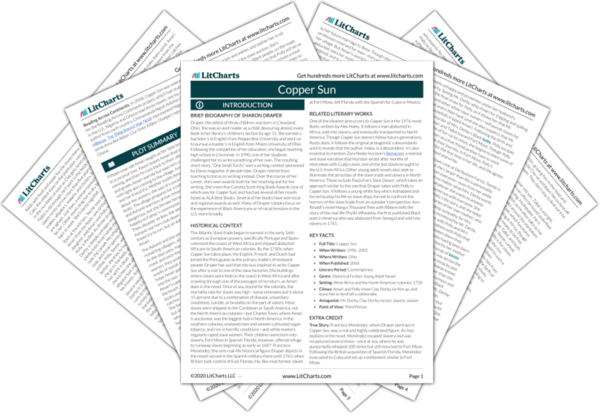Babies—and, sometimes, older children—are symbols of hope and innocence. The many babies and children who are murdered or who otherwise die during the journey to the colonies, including Esi’s unborn first child and Amari’s brother Kwasi, represent the lost innocence of people abducted in Africa and enslaved in the American colonies. However, the children and infants whom Amari encounters in the colonies suggest there’s still hope. Tidbit, though a slave, is bright and happy, and he shows Amari that there’s something worth fighting for: his future, his right to life, and ultimately his ability to carry on the story of his ancestors and maintain the ties to African culture. This is ultimately what helps Amari accept and find peace when she realizes she’s pregnant with a baby that Clay Derby fathered through rape. Despite the horrific circumstances surrounding the baby’s conception, Inez encourages Amari to focus on the fact that her baby will, like Tidbit, offer Amari an opportunity to pass along her optimism, tenacity, and strength—especially in the face of such horrors.
The fate of Mrs. Derby’s own biracial infant daughter, however—Mr. Derby shoots her and her father, Noah, a slave, when the baby is only hours old—makes it clear that the hope that Black babies represent is especially tenuous. All Black slaves, whether children or adults, are in constant danger of being killed, raped, or otherwise harmed in some way, either directly by their masters or as a result of neglect. And the birth of Black babies may be hopeful for other Black people, but for white masters intent on keeping control of their slaves, those babies represent humanity, choice, and agency on the part of the Black slaves that directly threatens the control of those white masters.
Babies / Children Quotes in Copper Sun
“And that’s just the first part. Then you gotta tend to the plants and flood the fields and cut the stacks and thresh the seeds—seem like it go on forever. That’s what be in your future, Miz Africa. And when he get old enough, this here boy’s future too.”
Polly looked at Cato in disbelief. “They’d put Tidbit out there?” she asked, horrified. The thought of little Tidbit sweating and working in the dangerous swampy water made Polly feel ill.

Unlock explanations and citation info for this and every other Copper Sun quote.
Plus so much more...
Get LitCharts A+“My beautiful baby,” she murmured over and over. Finally calmer, she looked up at Teenie and the girls. “I must explain,” she whispered, “before I die.”
“You ain’t gonna die, Miz Isabelle,” Teenie assured her. “You is fit and fine. Everybody feels a little poorly after havin’ a baby.”
Tenderly, Mrs. Derby touched the infant’s velvety brown face. “You don’t understand. My husband will kill me,” she said with certainty.
[...]
“He would never do such a thing!” But Teenie knew that Mr. Derby was probably quite capable of murder and would be within the limits of social acceptability to do so for this impropriety.
He took a deep breath, then said quietly, “I am ashamed to be a human being this morning. I witnessed not just murder last night, but violence and cruelty and vicious hatred. By saying nothing, I feel I am as responsible as my so-called friend who pulled the trigger.”
Amari and Polly exchanged stunned looks.
Dr. Hoskins continued. “I am just one man. I don’t know how to fight everything that is happening around me. I don’t understand how one man can own another. And I don’t know how to stop it.” He looked around at the deep woods and the darkness within them. “But I can help the three of you.”
What shall I do? Amari thought helplessly. She willed herself to imagine her mother who would know what to say and how to comfort her. All of her mother’s dreams of growing old and watching her grandchildren play had been brutally dashed into the dust. This child carries the spirit of my mother, Amari realized suddenly, as well as the essence of her father, little Kwasi, the murdered people of her village, and the spirits of all her ancestors.
She inhaled sharply as she thought of Mrs. Derby, of the infant who had been given no chance to live, and of all the other women, both black and white, who continued to suffer as property of others.












